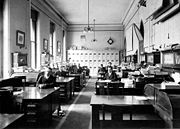
Press gallery
Encyclopedia

Parliament
A parliament is a legislature, especially in those countries whose system of government is based on the Westminster system modeled after that of the United Kingdom. The name is derived from the French , the action of parler : a parlement is a discussion. The term came to mean a meeting at which...
, or other legislative body, where political journalists are allowed to sit or gather to observe and then report speeches and events. This is generally one of the galleries overlooking the floor of the house and can also include separate offices in the
legislative or parliamentary buildings accorded to the various media outlets, such as occurs with the Strangers Gallery
Strangers Gallery
The Strangers' Gallery is set aside for members of the public at the British House of Commons, and is intended for both invited and uninvited members of the public to watch the proceedings of the House. A similar gallery exists in the House of Lords. Members of the public may obtain tickets from...
in the British House of Commons
British House of Commons
The House of Commons is the lower house of the Parliament of the United Kingdom, which also comprises the Sovereign and the House of Lords . Both Commons and Lords meet in the Palace of Westminster. The Commons is a democratically elected body, consisting of 650 members , who are known as Members...
or the Canberra Press Gallery
Canberra Press Gallery
The Canberra Press Gallery, officially called the Federal Parliamentary Press Gallery, is the name given to the approximately 180 journalists and their support staff, including producers, editors and camera crews, who report the workings of the Australian Parliament...
in the Australian Parliament.
The United States Senate
United States Senate
The United States Senate is the upper house of the bicameral legislature of the United States, and together with the United States House of Representatives comprises the United States Congress. The composition and powers of the Senate are established in Article One of the U.S. Constitution. Each...
established its first press gallery in 1841, and both the House of Representatives
United States House of Representatives
The United States House of Representatives is one of the two Houses of the United States Congress, the bicameral legislature which also includes the Senate.The composition and powers of the House are established in Article One of the Constitution...
and Senate set aside galleries for reporters when they moved into their current chambers in 1857 and 1859. (The White House did not designate a press room until 1902.) The press galleries in Congress are operated by superintendents, appointed by the House and Senate
sergeants at arms, and by Standing Committees of Correspondents, elected by the journalists.
The first Standing Committee of Correspondents was created in 1879 to eliminate lobbyists from the press galleries. With the approval of House and Senate leaders, reporters drafted a set of requirements for accreditation. Press passes were issued only to those whose primary source of income was journalism, and who reported by telegraph to a daily newspaper. The rules eliminated lobbyists, but also women and minorities. Nineteenth-century women
reporters were confined to social news coverage, which did not justify the cost of telegraphing. African American reporters were limited to the black press, which were then all weekly papers. Not until the 1940s did women and minorities overcome these obstacles.
In the twentieth century, the same rules denied press passes to radio reporters, unless they simultaneously reported for daily newspapers. In response to complaints from broadcasters, Congress in 1939 created a Radio Gallery in each house, later the Radio-TV galleries. Congress also established a Periodical Press Gallery for magazine and newsletter writers, and a Press Photographers’ Gallery. By the 1990s, Internet reporters and bloggers began applying for press
passes. After initial resistance, the press galleries adjusted their rules to admit those who earn their living from their journalism, and who are not underwritten by advocacy groups.
Reporters who occupy the press galleries are known as the press corps. Now numbering in the thousands, they rely on similar press operations in all three branches of the government. Despite the government’s efforts to accommodate the press corps, however, the relationship between the press and the politicians remains essentially adversarial, punctuated by politicians’ complaints of bias and misrepresentation, and by reporters’ protests against government attempts
to manipulate the news.
Sources
- Timothy Cook, Governing with the News: The News Media as a Political Institution (Chicago: University of Chicago Press, 1998).
- Elaine S. Povich, Partners & Adversaries: The Contentious Connection between Congress and the Media (Arlington Va: The Freedom Forum, 1996).
- Donald A. Ritchie, Press Gallery: Congress and the Washington Correspondents (Cambridge: Harvard University Press, 1991).
- Donald A. Ritchie, Reporting from Washington: The History of the Washington Press Corps (New York: Oxford University Press, 2005).
External links
- Maple Leaf Web: Parliamentary Press Gallery & Canadian Politics
- http://www.senate.gov/galleries/daily/rules2.htm

